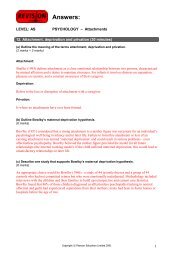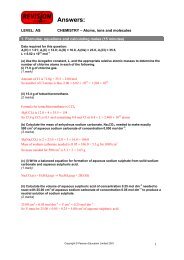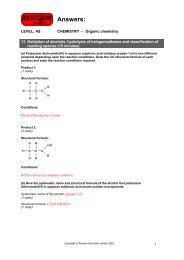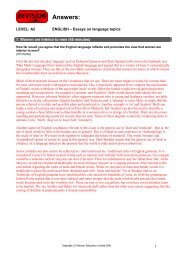The Dove Campaign for Real Beauty - Pearson
The Dove Campaign for Real Beauty - Pearson
The Dove Campaign for Real Beauty - Pearson
Create successful ePaper yourself
Turn your PDF publications into a flip-book with our unique Google optimized e-Paper software.
Chapter 2 Sustainable marketing: marketing ethics and social responsibility3. Describe the principles of socially responsible marketingMany companies originally opposed these social movements and laws, but most of themnow recognise a need <strong>for</strong> positive consumer in<strong>for</strong>mation, education and protection. Somecompanies have followed a policy of enlightened marketing which holds that a company’smarketing should support the best long-run per<strong>for</strong>mance of the marketing system.Enlightened marketing consists of five principles: consumer-oriented marketing, customervaluemarketing, innovative marketing, sense-of-mission marketing and societal marketing.Because business standards and practices vary from country to country, the issue ofethics poses special challenges <strong>for</strong> international marketers. <strong>The</strong> growing consensus amongtoday’s marketers is that it is important to make a commitment to a common set of sharedstandards worldwide.4. Explain the role of ethics in marketingIncreasingly, companies are responding to the need to provide company policies and guidelinesto help their employees deal with questions of marketing ethics. Of course, even thebest guidelines cannot resolve all the difficult ethical decisions that individuals and firmsmust make. However, there are some principles that marketers can choose among. Oneprinciple states that such issues should be decided by the free market and legal system. Asecond, and more enlightened, principle puts responsibility not in the system but in thehands of individual companies and managers. Each firm and marketing manager must workout a philosophy of socially responsible and ethical behaviour. Under the societal marketingconcept, managers must look beyond what is legal and allowable and develop standardsbased on personal integrity, corporate conscience and long-term consumer welfare.5. Understand the dimensions of sustainable marketingSustainable marketing recognises that the long-term survival of an organisation goesbeyond serving the wants and needs of today’s customers. It recognises the conflict betweenthe short-term needs <strong>for</strong> profit and customer gratification to build an operation that enhancesthe lives of its current and future stakeholders. <strong>The</strong> first dimension of sustainable marketinglooks to the needs of tomorrow’s customers as well as today’s and the need to address environmentalissues that endanger the livelihood of all. This means concern <strong>for</strong> shoddy goodsthat unintentionally endanger customers (such as power motorcycles), intrinsically dangerousproducts (such as cigarettes), consumption that damages the lives of others (such as cornbasedethanol fuel that drives up the cost of the food of poor people) or consumption thatendangers future generations (such as our appetite <strong>for</strong> energy to fuel our lifestyle).Sustainable marketing’s second dimension means assuring the survival of a business inorder that it can continue to serve future customers. That means a concern that the companyhas the agility to evolve as markets change and the governance to assure its well-being.Discussing the concepts1. Marketing receives much criticism, some justified and much not. Which of the major criticismsof marketing discussed in the chapter do you think are most justified? Which are leastjustified? Explain.115
















